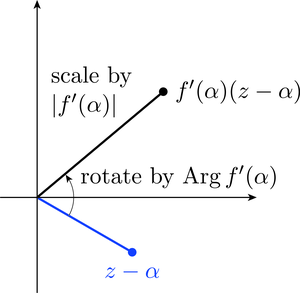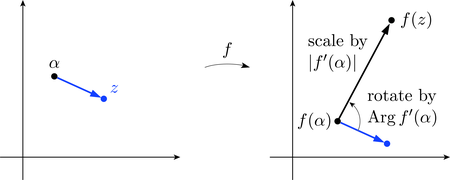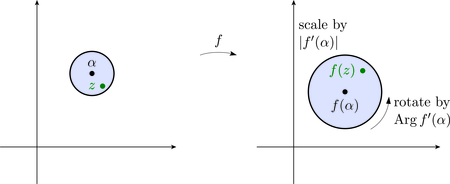1.5 A geometric interpretation of derivatives
As we mentioned in this session’s introduction, the derivative of a real function is often pictured geometrically as the gradient of the graph of the function. This interpretation is useful in real analysis, but it is of little use in complex analysis, since the graph of a complex function is not two-dimensional.
Fortunately, there is another way of interpreting derivatives that works for complex functions.
If a complex function is differentiable at a point , then any point close to is mapped by to a point close to .
Indeed, by the Linear Approximation Theorem,
where as . So if , then, to a close approximation,
Multiplication of by has the effect of scaling by the factor and rotating it about 0 through the angle ; see Figure 6. We refer to as a complex scale factor, because it causes both a scaling and a rotation.
We can rewrite the equation above as
From this we see that is obtained by scaling and rotating the vector based at by the complex scale factor , as illustrated in Figure 7.
Another useful way to picture how behaves geometrically is to consider the effect it has on a small disc centred at (still assuming that ). From equation 2 (above), we see that, to a close approximation, a small disc centred at is mapped to a small disc centred at . In the process, the disc is rotated through the angle , and it is scaled by the factor (see Figure 8). As usual, the rotation is anticlockwise if is positive, and clockwise if it is negative.
The geometric interpretation of derivatives is more complicated if , and we do not discuss it here.
Example 7
Using the notion of a complex scale factor, describe what happens to points close to under the function .
Solution
To a close approximation, a small disc centred at is mapped by to a small disc centred at
In the process, the disc is scaled by the factor and rotated through the angle .
Now , so
which has modulus and principal argument .
So scales the disc by the factor and rotates it anticlockwise through the angle .
Exercise 10
Using the notion of a complex scale factor, describe what happens to points close to under the function
Answer
To a close approximation, a small disc centred at is mapped by to a small disc centred at
In the process the disc is scaled by the factor and rotated through the angle .
By the Quotient Rule,
So
This has modulus and principal argument .
So scales the disc by the factor and rotates it clockwise through the angle .
It is important to bear in mind that the complex scale factor interpretation of a derivative is only an approximation, and that it is unlikely to be reliable far from the point under consideration.



